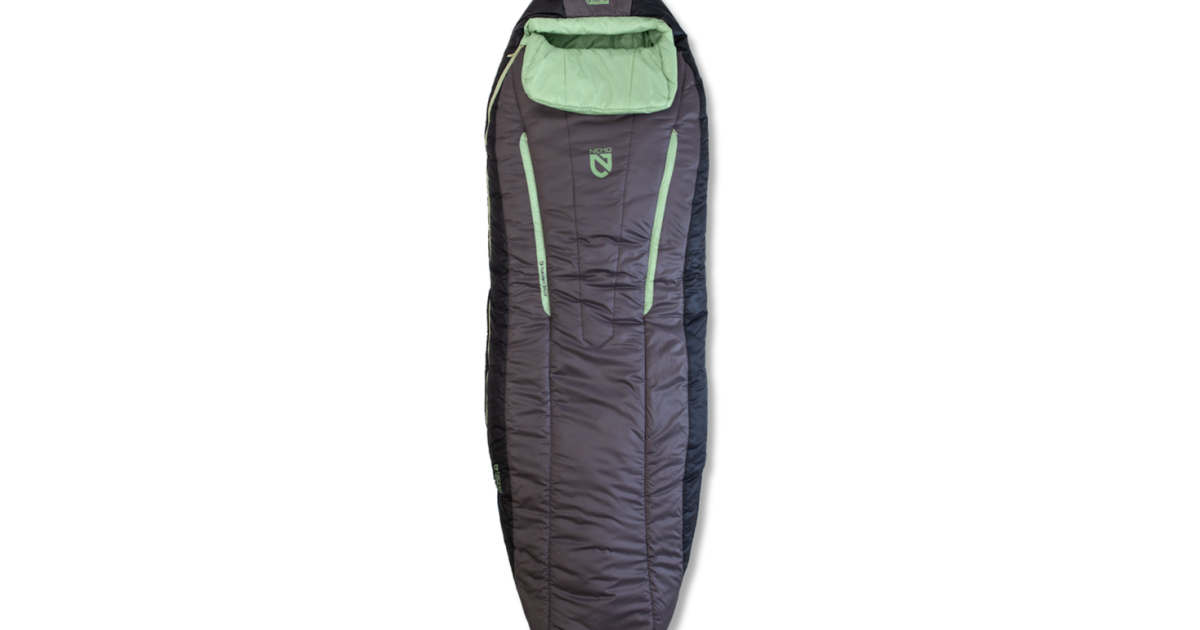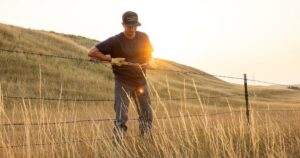
Outdoor gear has always seemed a great candidate for success in the circular economy. The products are generally durable, can be repaired and refurbished, and have a customer base that cares about preserving the environment.
I’m an avid tent camper and have run through my share of sleeping bags over the years. The newest circular economy innovation in outdoor gear that excites me is a synthetic sleeping bag from Nemo Equipment. The Forte sleeping bag has been a bestseller for some time for Nemo, which has long encouraged users to repair its bags to keep them in use longer.
Other brands have dipped their toes into circular economy solutions to varying degrees and with mixed results. One of the first efforts was Patagonia’s "Don’t Buy This Jacket" campaign in 2011, which aimed to educate consumers about the environmental impacts of purchasing new products. It was a clever program, but quickly resulted in increased sales of new Patagonia gear. Patagonia has continued its circularity journey and is viewed as a leader in this space.
More recently, the likes of Arc’teryx, REI and Cotopaxi have launched into resale with Trove’s recommerce platform. Again, resale is a great step, but we haven’t seen data to show that recommerce for these brands is leading to decreased sales of new products.
Circular economy efforts are also showing up prominently in outdoor brands’ sustainability reports. VF Corporation, whose brands include The North Face, Icebreaker and Smartwool, devoted a whole section of its 2022 "Made for Change" report to circularity. There it highlights efforts in product design, maximizing product lifecycle, managing for products' end-of-life and developing reverse supply chains. In other words, a circular economy for outdoor gear and apparel is no longer a fringe concept.
We ask ourselves: Is this product worth the resources it will require to make it?
Nemo has designed its newest Forte sleeping bag, released in the spring, for full recyclability at the end of its useful lifetime. While most sleeping bags use five to 10 polymers, the Forte’s designers set out to achieve maximum recyclability through limiting the number of materials, according to Nemo. More than 97 percent of the sleeping bag by weight is from a single material, mostly recycled polyester (rPET). This design, combined with a recycling partnership with Unifi, allows Nemo to keep these bags out of the landfill.
The Forte Endless Promise is a great innovation that should excite anyone interested in the circular economy. Nemo is also releasing several more products in the Endless Promise line over the coming years, including down sleeping bags and backpacks, with its sights set on eventually becoming fully circular for all products.
Not only has Nemo designed a sleeping bag with recycling in mind, but it has foregone a small pilot to fully apply the new circular model to all Forte synthetic sleeping bags. This all-in mentality, avoiding messy pilot programs, feels like the best way to avoid confusion in the market and frustration for users.
I had a chance to chat by email this past week with Theresa McKenney, Nemo’s director of sustainability. Nemo, a New Hampshire-based company founded in 2002, sells its products at retailers such as REI and Cabela’s as well as through direct sales on its website. Nemo is well-regarded for high quality and thoughtful design, so this foray into circularity does not come as a surprise.
Jon Smieja: Tell us a bit about why Nemo is taking on this challenge around circularity and the Endless Promise line of products?
Theresa McKenney: Eighty-seven percent of Nemo’s greenhouse gas emissions happen before our products leave the factory. Our first design directive is to never bring anything to market that doesn’t offer a meaningfully better experience for the customer. We ask ourselves: Is this product worth the resources it will require to make it? Should this product exist?
If we think it should, we then try to make it with the best performing, most sustainable materials possible. To us, circularity is the final piece of the puzzle. The goal of our Endless Promise program is to keep good gear out of the landfill with vetted repair, resale and recycling pathways.
Smieja: One product is out, the synthetic Forte Endless Promise sleeping bag. I have one and love it. If you could, I'd love to hear what kinds of challenges you faced in developing that product and how you overcame them?
McKenney: The Forte Endless Promise brings a circularity-focused update to our No. 1 selling synthetic sleeping bag line. We didn’t want to approach the problem with a small pilot; we wanted to encourage systemic changes in our product development process. Our first challenge was finding a recycling partner to understand our design parameters. What makes a product recyclable? For our first Endless Promise product, a synthetic sleeping bag, we learned that it could be mechanically recycled if the materials were as mono-polymer as possible. Forte is greater than 97 percent polyester by weight — mostly rPET [recycled polyester].
We did have some challenges during the design process. Our initial recycling partner needed a 40,000 pound test run; that’s the equivalent of a year’s worth of sleeping bags for us. We went back to the drawing board and connected with Unifi, a recycler based in North Carolina. We passed their recyclability testing and launched our first Endless Promise product.
Smieja: Based on conversations we've had in the past, I know you are working with other partners on these projects as well. Can you share some of those partnerships up and down your supply chain making this work possible?
McKenney: Unifi was our first recycling partner with the 2023 launch of Forte Endless Promise. In 2024, we’re expanding our Endless Promise collection to two additional categories. Down sleeping bags and backpacks, a completely new product line for us.
Both down bags and backpacks required different recycling streams. We needed to extract down as a new process step, and the backpacks were too materially complex for mechanical recycling. We’re partnering with two Los Angeles-based companies to solve these issues: Allied Feather & Down and Ambercycle.
We started in the U.S., but we’re expanding repair and recycling options in mainland Europe in 2024. We’ll be announcing those partnerships at ISPO [in Munich] next month.
Smieja: I know you follow regulatory action around the globe. Are any of those policies helping drive this work, or do you see the Endless Promise work as a way to get out ahead of them?
McKenney: Our Endless Promise line is more reflective of our values as a team than a response to regulatory pressure. That said, there’s a lot of EPR activity happening right now, both in the U.S. and abroad. We’re in support of producer responsibility and are working alongside organizations like California Outdoor Recreation Partnership and Outdoor Industry Association to provide feedback to legislators.
Smieja: I'm curious about the product design teams. How were they trained to think about circular economy principles? Were they excited to take on this added challenge? What have you learned about training internal teams?
McKenney: Circular design and sustainable design are now integrated into our development process, but it has been something that we’ve been working towards since our early days as a brand. Back in 2008, Cam [Brensinger, founder & CEO of Nemo Equipment] and the design team challenged themselves to build a tent that could be put in your curbside recycling bin at the end of its useful life. While the systems were not available to us at that time, we did launch the Nano OZ backpacking tent made from recycled polyester fabrics, reground polyoxymethylene and recycled ABS hardware, and we even had an option for handmade bamboo poles.
For us, a win is when we design a product that delivers the best performance and has the lowest footprint possible.
In 2019, as a company, we read Paul Hawken’s book "Drawdown." It was a great step in getting the entire team thinking differently from a personal and work perspective.
Our product team led the charge on the Endless Promise project — once they had guidance on design constraints, they made it happen. It’s been an energizing project for all of us. Nemo's sustainability team will set up trainings on big-picture topics, but much of the value we can bring is sustainability troubleshooting. How do we get the product back to NEMO? What is the network of chemical recyclers in Europe? We can chase down a lot of those questions.
Smieja: How are you going about training customers? Retailers? Clearly the biggest benefit of this program will come if the products are returned as anticipated. How do you make sure that happens?
McKenney: I think it’s a brand’s responsibility to make circularity easy for consumers and retailers. In the U.S., Nemo offers a $20 incentive to trade in products for recycling. Every Endless Promise product is clearly marked with a QR code inviting folks to learn more about the program. From that menu, you can learn how to repair, resell and recycle the product, based on where you are. As we expand circularity options to more markets, we’ll continue to update the page.
Smieja: To some degree I have to imagine your customers self-select as the kind of people that might care about these initiatives. First question is whether that is your experience. Second, any advice for brands thinking about circular economy initiatives that might not have the same motivated customer base?
McKenney: Sustainability is becoming increasingly important to customers — both retailers and consumers. We still see performance as the top priority. For us, a win is when we design a product that delivers the best performance and has the lowest footprint possible.
For brands thinking about circular economy initiatives, I’d recommend starting with a product that is not materially complex. The more individual materials or blends that are in a product, the more complex recycling pathways are.
Oh, I almost forgot. This is not a product review, but I absolutely love this sleeping bag, whose prices are comparable to others on the market. After using it a few times over the summer at state parks in my home state of Minnesota, I can say it is one of the most comfortable sleeping bags I’ve ever used. For a side sleeper like myself — because I snore too much on my back — the Forte bag offers a roomy leg design that allows me to move around freely.
- SEO Powered Content & PR Distribution. Get Amplified Today.
- PlatoData.Network Vertical Generative Ai. Empower Yourself. Access Here.
- PlatoAiStream. Web3 Intelligence. Knowledge Amplified. Access Here.
- PlatoESG. Carbon, CleanTech, Energy, Environment, Solar, Waste Management. Access Here.
- PlatoHealth. Biotech and Clinical Trials Intelligence. Access Here.
- Source: https://www.greenbiz.com/article/whats-inside-sleeping-bags-endless-promise
- :has
- :is
- :not
- :where
- $UP
- 000
- 1
- 10
- 2008
- 2011
- 2019
- 2022
- 2023
- 2024
- 40
- 7
- 97
- a
- About
- abroad
- ABS
- absolutely
- According
- Achieve
- Action
- activity
- added
- Additional
- advice
- After
- again
- ahead
- aimed
- All
- allows
- almost
- alongside
- also
- always
- an
- and
- Announcing
- Anticipated
- any
- anyone
- anything
- apparel
- Apply
- approach
- ARE
- around
- article
- AS
- ask
- At
- available
- avoid
- avoiding
- back
- bag
- bags
- Bamboo
- base
- based
- BE
- because
- becoming
- been
- before
- benefit
- BEST
- Better
- Biggest
- BIN
- Bit
- blends
- board
- book
- both
- brand
- brands
- bring
- Brings
- build
- but
- buy
- by
- Campaign
- CAN
- candidate
- care
- Carolina
- categories
- ceo
- chain
- chains
- challenge
- challenged
- challenges
- Chance
- change
- Changes
- charge
- chase
- chemical
- circular economy
- clearly
- code
- collection
- combined
- come
- comfortable
- coming
- Companies
- company
- comparable
- completely
- complex
- concept
- confusion
- connected
- constraints
- Consumers
- continue
- continued
- conversations
- CORPORATION
- could
- Curbside
- curious
- customer
- customer base
- Customers
- data
- Days
- decreased
- Degree
- delivers
- Design
- design process
- designed
- designers
- developing
- Development
- DID
- different
- direct
- Director
- do
- does
- Doesn’t
- down
- drawing
- drive
- during
- Early
- easy
- economy
- educate
- efforts
- Emissions
- encourage
- encouraged
- end
- Endless
- Entire
- Environment
- environmental
- equipment
- Equivalent
- Ether (ETH)
- Europe
- Even
- eventually
- EVER
- Every
- excited
- excites
- exist
- Expand
- expanding
- experience
- extract
- fabrics
- Face
- faced
- factory
- feedback
- few
- final
- finding
- First
- five
- follow
- Footprint
- For
- For Consumers
- Foray
- Forte
- Founded
- founder
- Fridays
- from
- frustration
- full
- fully
- GAS
- Gear
- generally
- get
- getting
- globe
- goal
- going
- good
- great
- greater
- greenhouse gas
- Greenhouse gas emissions
- guidance
- had
- happen
- Happening
- happens
- Hardware
- Have
- hear
- helping
- High
- highlights
- Home
- How
- How To
- HTML
- HTTPS
- i
- if
- imagine
- Impacts
- important
- in
- In other
- Incentive
- include
- Including
- increased
- increasingly
- individual
- industry
- initial
- initiatives
- Innovation
- inside
- integrated
- interested
- internal
- into
- inviting
- issues
- IT
- ITS
- Keep
- Kind
- Know
- launch
- launched
- leader
- leading
- LEARN
- learned
- Leave
- Led
- legislators
- Life
- lifecycle
- lifetime
- like
- likes
- Line
- Long
- longer
- los
- Lot
- love
- lowest
- made
- mainland
- make
- MAKES
- Making
- managing
- marked
- Market
- Markets
- material
- materially
- materials
- maximizing
- maximum
- me
- mechanical
- Menu
- might
- mind
- minnesota
- mixed
- model
- Month
- more
- most
- mostly
- motivated
- move
- much
- Munich
- my
- myself
- nano
- needed
- network
- never
- New
- new product
- new products
- Newest
- next
- no
- node
- North
- north carolina
- now
- number
- of
- offer
- Offers
- on
- once
- ONE
- only
- Option
- Options
- or
- organizations
- Other
- Others
- our
- ourselves
- out
- Outdoor
- over
- page
- parameters
- parks
- partner
- partnering
- partners
- Partnership
- partnerships
- passed
- past
- Patagonia
- pathways
- Paul
- People
- percent
- performance
- performing
- personal
- perspective
- piece
- pilot
- plato
- Plato Data Intelligence
- PlatoData
- policies
- Polymers
- possible
- pound
- preserving
- pressure
- Prices
- principles
- priority
- Problem
- process
- producer
- Product
- product design
- product development
- product lifecycle
- Products
- Program
- Programs
- project
- projects
- promise
- provide
- purchasing
- put
- puzzle
- QR code
- quality
- question
- Questions
- quickly
- Read
- recently
- recommend
- recycling
- regulatory
- released
- releasing
- repair
- Reports
- require
- required
- resell
- Resources
- response
- responsibility
- resulted
- Results
- retailers
- reverse
- review
- right
- Run
- s
- Said
- sales
- same
- say
- Second
- Section
- see
- seemed
- seen
- Selling
- Sells
- sent
- set
- several
- Share
- should
- show
- showing
- side
- Sights
- since
- single
- small
- So
- Solutions
- SOLVE
- some
- something
- Space
- spring
- started
- Starting
- State
- Step
- Still
- streams
- subscribe
- success
- such
- summer
- supply
- supply chain
- Supply chains
- support
- sure
- surprise
- Sustainability
- sustainable
- synthetic
- systemic
- Systems
- Take
- taking
- team
- teams
- tell
- tent
- test
- Test run
- Testing
- than
- that
- The
- their
- Them
- themselves
- then
- There.
- These
- they
- think
- Thinking
- this
- those
- Through
- time
- times
- to
- too
- top
- Topics
- towards
- trade
- trained
- Training
- trainings
- try
- two
- u.s.
- understand
- Update
- us
- use
- used
- users
- using
- value
- Values
- varying
- Ve
- vetted
- viewed
- want
- wanted
- was
- Way..
- we
- Website
- week
- weekly
- weight
- WELL
- went
- were
- What
- What is
- when
- whether
- which
- while
- whole
- whose
- why
- will
- win
- with
- words
- Work
- working
- worth
- years
- you
- Your
- zephyrnet









